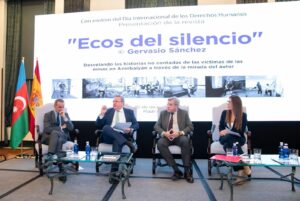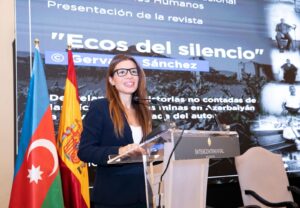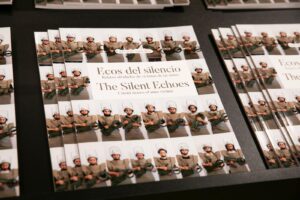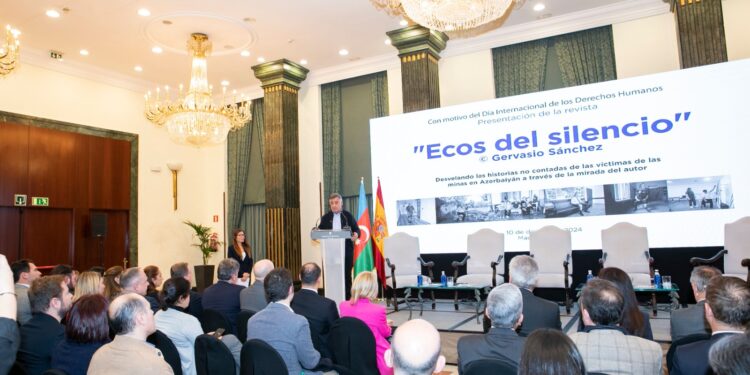Cristina Marcén/Julio García
The Spanish journalist and photographer, Gervasio Sánchez, has presented with the Embassy of Azerbaijan in Madrid, the magazine ‘Echoes of Silence: Forgotten Accounts of Mine Victims’, It brings together more than 70 photographs illustrating over 30 interviews with victims in the Garabaj and Zanguezur Oriental regions, as well as showing the devastation in the liberated territories and reconstruction efforts.
The event, organized by the Embassy of Azerbaijan and at the initiative of Mr Sánchez, took place on 10 December, on the occasion of World Human Rights Day, in order to reflect on the problem of landmines in that country.
Gervasio Sánchez, a specialist in armed conflicts, collects the findings of his visit to the country between April and May this year. It was during this period that he documented stories of landmine victims and their impact on the region.
The photo report includes ruins in liberated territories and large-scale reconstruction and construction work carried out by Azerbaijan. Also included are portraits of mine victims who were injured in the explosions during the First and Second Garabaj Wars.
During the launch of this publication, Sanchez described the magnitude of the mine problem in Azerbaijan and stressed that he had visited more than 30 countries affected by the threat of mines, but that he had not encountered such a great threat anywhere else in the world.
The photojournalist assured that the war does not end on the date mentioned in Wikipedia, but when all its consequences have been eliminated and added that Azerbaijan is currently clearing its territories of mines using its own resources. In this regard, he warned that without international support, this process could take many years.
The event was attended by Spanish deputies and senators, including Senator Pere Juan Pons (PSOE), Pablo José Antonio Monago (PP); the coordinator of the Technical Office of the Director of the International Development Cooperation Agency (AECID) To the Ministry of Foreign Affairs, European Union and Spanish Cooperation, Pablo Gan Quesada; Deputy of Milli Majlis in the Parliament of Azerbaijan, Chairman of the Azerbaijan-Spain friendship group; Nariman Gasimov; the representative of the Azerbaijan Mine Action Agency (ANAMA); and Jordi Xucla, professor of international relations at Ramon Llull University. The invited speakers provided detailed information on the landmine problem in our country.

During the event, Pere Joan Pons, who knows the security processes in the region and has visited Azerbaijan on several occasions, drew attention to the humanitarian, economic and ecological consequences of anti-personnel landmines.
In assessing the problem of landmines in Azerbaijan in the context of the environment, Pons pointed out that among the countries which are directly affected by the environmental impact, Countries with landmine problems are among the most affected, and he stressed that demining contributes to environmental protection and climate resilience.
Pons also stressed a telling fact: 60% of the 20 countries most affected by climate change are also suffering from the environmental consequences of the devastating effect of mines, so that “Climate and mines are a double penalty for the communities living in these territories”.
Monago, a member of the Joint Commission on National Security and Defence in Spain, spoke about his visit to Garabaj this year and stated that he had first-hand experience of the consequences of the mine problem in Azerbaijan.
He reported that during his visit to the city of Agdam, he could not find a single building that had not been destroyed – the city of Agdam has become an open-air museum city which testifies to the bitter reality. Despite the end of the war, anti-personnel mines pose a constant threat to people, the return of internally displaced persons, economic development and infrastructure.
The PP senator, who shared Spain’s extensive experience in demining, stated that mine-clearance activities in Azerbaijan are not limited to clearing specific areas.
He explained that this work also includes key aspects such as generating hope for the future of people, honoring the memory of mine victims who lost their lives, ensuring justice and helping the wounded rebuild their lives.
In this context, Monago, when assessing the work done by Gervasio Sánchez to raise awareness about the mine problem, stressed that he not only documented the past, but also called us to assume collective responsibility. He therefore considered that the journal acquired a relevance which went beyond its original purpose, and expressed his hope that on his next visit to Agdam the danger of mines would no longer exist.
Pablo Gan Quesada, for his part, noted that the landmine problem facing Azerbaijan today will also be experienced in Ukraine in the future and stressed the importance of international attention to humanitarian problems related to mines.

Journalist and writer Ana de Santos moderated the interventions and shared her views on how the problem of landmines constitutes a humanitarian disaster, It is also an obstacle to the return of thousands of internally displaced Azerbaijanis to their homes.
The event was also attended by leaders of the Directorate-General for Eastern Europe, Asia and the Pacific of the Ministry of Foreign Affairs, European Union and Cooperation of Spain, as well as senior representatives of other state institutions and parliamentary chambers. The event also included representatives of the diplomatic corps and international agencies accredited in the country, ambassadors, officials from the Madrid City Council, as well as researchers from various think tanks and academic circles, Cultural personalities, representatives of the business sector and NGOs.
The event concluded with an electronic exhibition of photographs taken by Gervasio Sánchez in Azerbaijan.

Thanks to the photographs of G. Sánchez, the Spanish society was able to learn about the activities of the first women demining teams in Azerbaijan and their high professional involvement in demining operations.
It is also noted that this event is the first time readers have become familiar with the work of a European citizen who highlights the magnitude of mine contamination in Azerbaijan.







